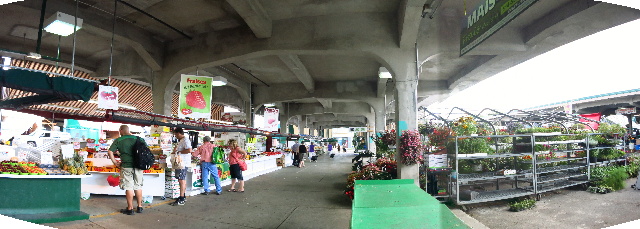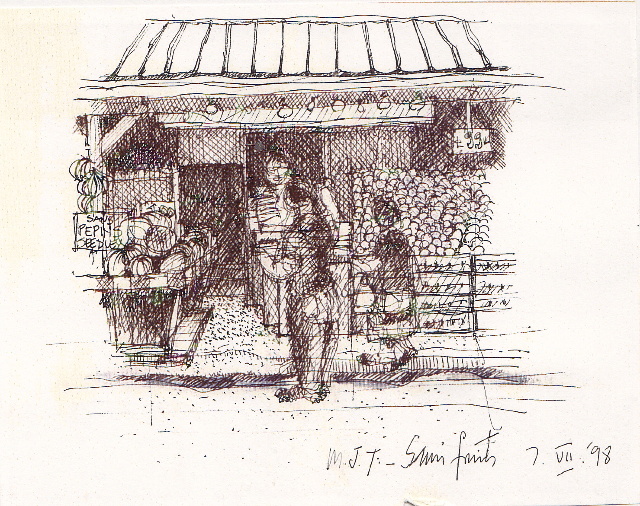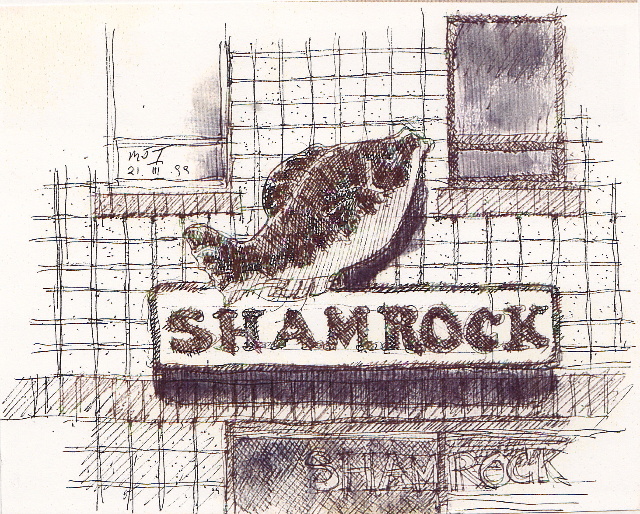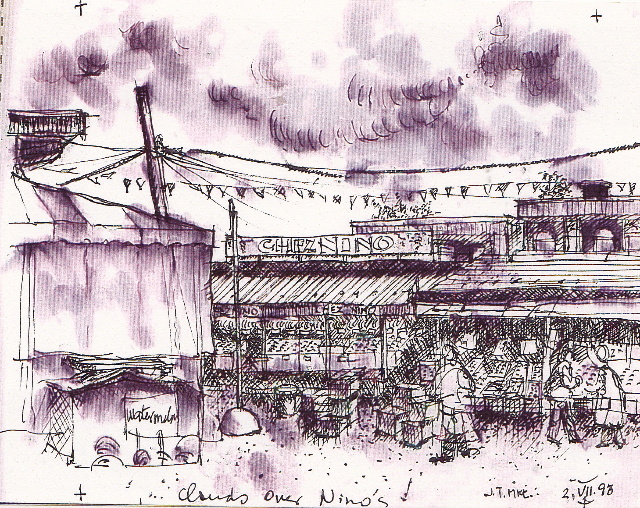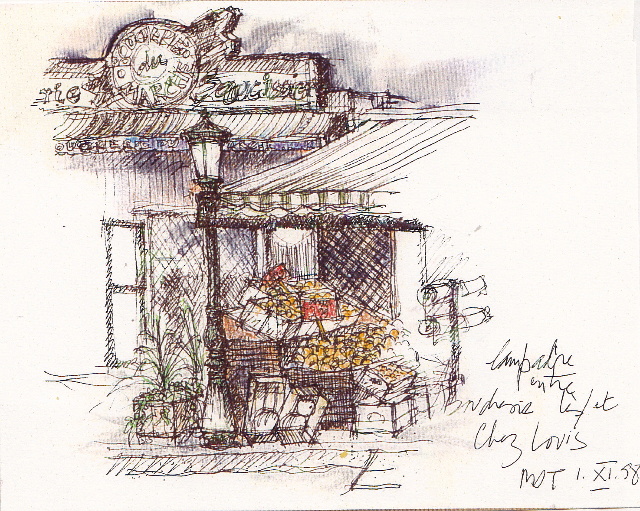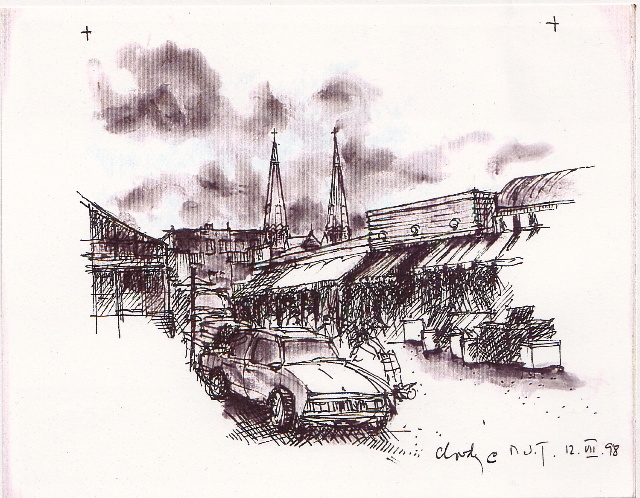Street Corner Market … bare asphalt under a tent roof.
This corner lot, property of the city next to a primary school, is a 24/7 public market from April to November, a Xmas tree lot in December, and is snowed under for the rest of the year.
Throughout these three states the bare asphalt is its floor … the basic condition needed, I think, for any setting to have a Commons profile.
The occupant of the moment brings everything along to run his business on a piece of ground the locals know belongs to them; he then takes everything away with him, leaving the ground bare as it should, with just a diagonal pathway across it as shortcut from one street to the other.
Jean-Talon Market, (identified as MJT in the sketches) … bare concrete floor under a concrete slab roof.
I had the privilege to observe during four seasons, and to record its stalls monthly with camera and sketchbook, one of Montreal’s oldest Public Market located on the edge of Montreal’s Little Italy.
I had the privilege of being something of an on-board street artist during that time and was given a stall for a couple of weekends at the end of my stay to exhibit my sketches and interact with the passers by.
I then returned to my academic environment to analyze my visual data in order to find out what it was that made that Public Market “work”; what in fact were the elements of its environmental dynamic.
I find today that the following elements, each illustrated with a sketch, to be germane to the founding mutuality basic to the sense of Commons i.e. a mutual involvement of users and public in security and maintenance, in respect of roles and identity, and in ordinary and more ritualistic usages.
A sketch is not a photograph because it is not produced the same way. Even if based on the same intelligence, the time it takes to do a sketch allows for the improbable to happen with the consequent need to select and synthesize the basic information or emotion about the scene sketched.
Elements of the market’s environmental dynamic.
1. Displaying
A Public Market produce displaying seems to reproduce the spirit of a road side farmer stand: same raised up presentation plane, same informal presence of the seller, same bare light bulb and elementary signage, same nearby stock to replenish the table, same sense of an encounter with freshness of produce and human presence, and not just an anonymous commercial transaction.
Of course instead of cultivated fields in the background we find a processing table taking produce from stock to basket or stack…and, all around, other stalls sharing in the spirit of friendly competition for displaying strategies, on the level playing field of the basic market physical structure as Commons.
2. Signing
Next to displaying, signing suggest quality and origin of produce in such a way as to be visible while respecting a spatial alignment that maintains the Commons notion of a level playing field for the vendors. (see second in-text photo)
The scale of signs can become “architectural” on the façade of the buildings surrounding the Public Market proper and, as these are more commercial they show a lack of Commons spirit.
A local V.S. foreign origin of produce is the basic information carried by signage; for example, Quebec berries are a Market staple while exotic olives, figs, fish, etc. will be carried by the surrounding shops.
Tough to associate fish with Ireland as Shamrock suggests … until, that is, one notices the location of the shop at a corner of Shamrock Street harking back to the ethnic group that had originally settled the area.
There is a lively historical and geographical discourse carried on by signing as one walks the inner and outer pathways of the Public Market adding cultural color to the product of cultivation!
3. Weather proofing
When storm threatens there is a net distinction between the means taken to protect produce and buyer within the Market and in the surrounding shops.
The ingenuity of the means used in the former is due to the fact that structures must be demountable while in the latter protective structures are permanent and the outlying display boxes can be hustled inside quickly.
The exiguity of Market stalls renders unfeasible the “quick retreat” strategies for their peripheral displays, which must therefore have their own built-in protective devises.
At the junction of the two areas we can witness a riot of colors and materials topped by festive flag lines accompanying electric cables … something like a brave “Commons front” under menacing low and heavy cloud formations.
4. Marketing
Placing one’s offer at the right time and in the right place vis-à-vis demand is the basic principle of sound market management, and the Public Market is no exception.
24/7 is one strategic pole, as we can see empty display elements waiting for favorable time of season to be placed and replenished; a marketing strategy favored by Public Market surrounding shops that benefit from larger client contact surface and longer opening time spans.
The other is the hit and run strategy, a bit free for all, to place event related produce (pumpkins for Halloween at outdoor Market season end, and flowers for Easter at its beginning) on various more movable displays, at the best client catching spots.
Depending on the time of the outdoor season there will be a jockeying of merchant stall location according to the formation of produce thematic areas. There is a hierarchy of choice for certain spots and areas between the merchants depending on seniority, etc
A mix of these strategies for optimum selling opportunities, will generally best suit the not always rational shopping behavior of the buyer … mix them well and the freshness of Commons use patterns makes its appearance.
5. Designing … in major and minor keys.
The Place du Marché du Nord, which the Jean Talon Market occupies, started as an outlying sport venue, associated to a tramway terminal station, that did not invite the kind of major-key design input as did the Halles of Paris, or as do beautifully proportioned and paved open urban area where a weekly market is held.
Nope, our Jean Talon Public Market had to develop its own minor-key design applied to lamp poles and other urban furnishing, as well as to a vaulted central circulation spine, hoping for some permanent urban visual signature in an otherwise plain basic Commons shelter structure.
This, not without the usual risk of dissonance between permanent and temporary structures design, nor without a certain charm resulting from the underlying tolerant and pragmatic approach to environmental design.
6. Reaching for Urbanity
Given the range and variety of its clientele, the Market has sprouted an all season extension built over an underground garage. Its shops have turned to up scale products, attractive to the residents of the high-density condominiums that have sprouted around it.
Bike racks abound, the resident musicians have moved indoors, the adjacent Italian community has enlarged its cultural center and built an adjoining senior residence, the largely Italian coffee joints have multiplied and the Middle Eastern shops come close second, if not first, in their exotic fare and produce offering.
Beyond the Market area one quickly finds the familiar parish church steeples that visually, if not socially, anchors the adjacent neighborhoods, on all four orients.
The socio-culturally mixed Jean-Talon Market, with its recent reaching for a degree of urbanity, has yet to develop the city wide distinctiveness of a major cultural and/or recreational magnet attractive to the new condo-generations, i.e., in which they can recognize themselves as actors of a new type of city Commons … its catchment area is still local and neighborly and multi generational … its touristic reputation is of course international.
Discussion
The development of an outdoor public market in a northern city may seem counter intuitive. Yet the Swedish town of Lund, for instance, has one in the format of an indoor fixed venue adjacent to a public open space given periodically to the holding of a seasonal open-air market, when not used as a classy municipal parking lot or a venue for cultural events.
In Montreal, the strong French tradition of public life is behind the development of its Public Market venues, the distinctiveness of each one depending on the socio-cultural color of adjacent neighborhoods, or its proximity to a major geographical and/or historical landmark in the city.
The most identifiable Commons traits in most Public Market are their seasonality of produce offering, their flexibility of stall occupancy and imagination of design, and the festive proprietary participation of sellers and clients in the life of their “own” Public Market.
Photo and sketches credit Maurice Amiel


